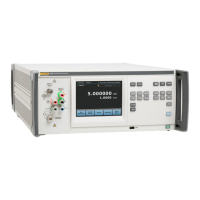Remote Commands
Local-to-Remote State Transitions 6
6-71
VAL?
Returns the value of the most recently completed input measurement.
Parameters
None
Response
The same response as the MEAS? query.
Local-to-Remote State Transitions
The Product can be operated either locally from the front panel, or remotely with
remote control commands. In addition to front panel and remote control
operation, the controller can be placed in a local lockout condition at any time by
remote command. When combined, the local, remote, and lockout conditions
yield four possible operating states:
• Local (Front-Panel Operation)
The Product responds to local and remote commands. This is normal front
panel operation. All remote commands are allowed to execute.
• Local with Lockout
Local with lockout is identical to local, except the Product will go into the
remote with lockout state instead of the remote state when it receives a
remote command. The local with lockout state is entered by executing the
LOCKOUT statement from an IEEE-488 controller, or by sending the
LOCKOUT command from a serial controller.
• Remote
When the Remote Enable (REN) line is asserted and the controller addresses
the Product as a listener, it enters the remote state. These conditions are
met, for example, when a GPIB controller executes any statement to the
Product.
Front panel operation is restricted to use of the power switch and the Local
Control selection. Touch Local Control or send the GTL (Go To Local)
interface message to return the Product to the local state. (One way to send
the GTL interface message in some controllers is by executing the LOCAL
statement.)
• Remote with Lockout
The Product can enter the remote with lockout state from remote or local with
lockout, but not directly from local. Remote with lockout is similar to the
remote state, but restricted: the Local Control is not shown on the display. To
return the Product to the local with lockout state, the GPIB controller sends
GTL. (With some IEEE-488 controllers, you can be do this manually by
executing a WBYTE statement.) To return the Product to the local state, the
GPIB controller unasserts the REN control line.
Table 6-7 summarizes the possible Remote/Local state transitions.

